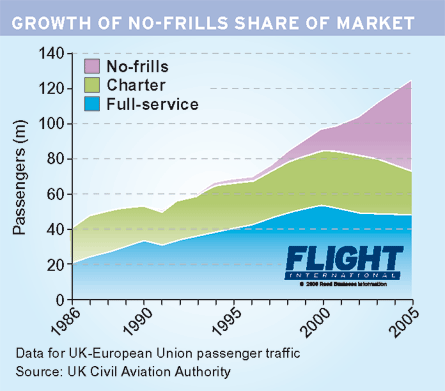CAA study finds that passenger numbers would have risen substantially without LCCs
"No-frills" low-cost carriers (LCC) have not caused UK-Europe air travel to grow any faster than it would have without them, according to a UK Civil Aviation Authority study of the industry.
This finding runs counter to "commonly held perceptions", says head of international aviation policy at the CAA's Economic Regulation Group (ERG) Alex Plant, explaining that the study was conducted to provide a policymaking base for the government and the CAA.

Without the advent of LCCs, "there would have been substantial growth anyway", says ERG director Dr Harry Bush. He points out that when the total growth in all three airline sectors - full-service, charter and LCCs - is projected from the period before1991 - when the no-frills sector began its rocketing rise from carrying 1% of passengers to the 45% it flies now - the total market growth rate was virtually unchanged (see graph).
Bush explains that this and earlier studies have found that passenger air travel rises in line with incomes more closely than any other indicator, with variations in ticket prices having a lesser influence than is normally assumed because air fares - especially low ones - are a relatively small proportion of the total trip cost for almost all business and leisure travellers.
Plant says the LCCs have become a significant provider in the steadily growing air travel market "mostly by substitution" - and most of that at the expense of the charter travel market (see graph).
Meanwhile, the study points out, the LCCs' way of operating has had an enormous influence on the way business is done in the UK-Europe marketplace, forcing the whole short-haul sector to move its products and cost bases closer to the no-frills model, or even adopt it.
Another of the dramatic changes wrought by the LCCs across Europe as a whole is to increase massively the variety of point-to-point services and frequencies, to the benefit of provincial or secondary destinations, as well as to secondary airports at major hubs.
Another non-intuitive result the CAA has discovered is that "there is little evidence of any marked change in the income and socio-economic profile of air passengers" since the LCCs entered the marketplace. Specifically, it says: "No frills carriers seem able to attract leisure passengers of similar income levels to those flying on full-service airlines, but it seems harder for them to do the same for business passengers."
The reasons behind the latter are complex, says the study, but one factor is probably the fact that the full-fare carriers serve the major business hubs via the primary airports.
Business people with lower incomes, however, are travelling in greater numbers now than they were before, suggesting that the LCCs may have created an opportunity for small businesses to travel more.
The CAA study was based on surveys of 200,000 passengers a year taken at UK airports during the 20-year study period.
So what does that mean for environmentalists who think taxes can reduce air travel. Read our blog.
Source: Flight International



















